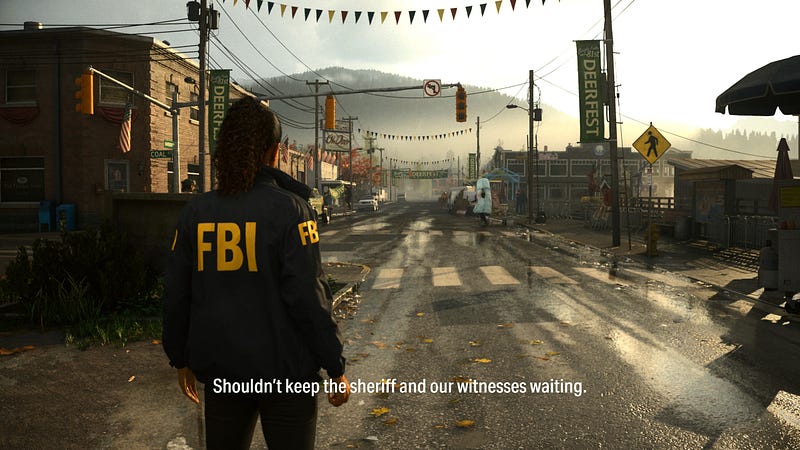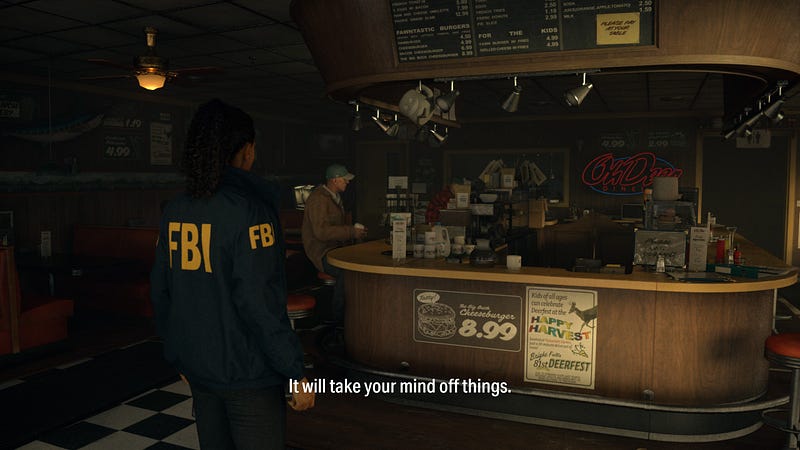Disappointment in Alan Wake II: A Thirteen-Year Wait for Less?
Written on
Chapter 1: Introduction to Alan Wake II
The anticipation for Alan Wake II has been immense, with fans eagerly awaiting its release for thirteen years. However, the question arises: did this wait result in a visual downgrade?

This review does not reveal major plot points beyond what has been disclosed in promotional content. It is based on the initial chapters of the game played on PC.
Remedy Entertainment’s latest offering, Alan Wake II, stands out as one of the most graphically impressive titles ever created, often coming close to a photorealistic experience. The environments and character animations are highly detailed. The narrative features the trademark twists and mysteries familiar to Remedy fans, referencing a wide array of their past titles. Moreover, the combination of live-action video and rendered graphics creates a unique blend that few other games have attempted.
While these elements are remarkable and align with my expectations as a long-time fan of Remedy’s work, including the original Max Payne, I find myself disappointed by the game’s core mechanics and level design. It feels as if my fondness for the Remedy universe has led me to engage with a game that provocatively poses the question, “What if The Last of Us lacked engaging gameplay?” Or perhaps, “What if Resident Evil 4 Remake stripped away its enjoyable features?”
Section 1.1: A New Direction in Survival Horror
For the first time, Remedy has ventured into the survival horror genre, leaving me puzzled about this direction. Perhaps the straightforward game mechanics were adopted to keep production costs manageable, allowing for a more elaborate artistic presentation. This studio is renowned for its fast-paced action games, having essentially shaped the modern third-person action genre with Max Payne. Titles like Quantum Break and Control further evolved this concept by incorporating new abilities and environmental destruction alongside traditional weapon-based gameplay.
The initial Alan Wake cleverly balanced its flashlight-and-gun combat system to create tension, complemented by narrative pauses that pushed the story forward. In stark contrast, the sequel appears to have lost this equilibrium, likely in response to feedback from those who preferred a less combat-heavy experience.

In Alan Wake II, gameplay mainly consists of moving towards cutscenes or tedious puzzles. While the story segments are captivating, they are often interrupted by obligatory visits to a convoluted mental menu system. When controlling the new character, Saga Anderson, this area allows her to organize her thoughts about the unfolding mysteries. Unfortunately, there is little actual detective work involved; the process involves selecting elements and placing them on a somewhat absurd conspiracy board.
Section 1.2: Mundane Puzzles and Gameplay
The remaining puzzles are equally uninspired, primarily revolving around the classic video game trope of locating the correct key or switch to progress. The sheer number of keys and similar items encountered in the early hours borders on parody. Optional puzzles also adhere to this formula, requiring players to unlock caches by finding codes or keys conveniently placed nearby.
Unlike the first game, where hidden stashes were marked with special glow paint visible only with the flashlight, the sequel introduces an additional layer of complexity reminiscent of outdated gaming design. If you found the lock codes in The Last of Us Part II to be overly simplistic, you will undoubtedly find the lock puzzles in this game frustrating. There are no engaging rope or physics puzzles akin to those in TLOU.
The glow paint’s return in this sequel seems to serve merely as a nostalgic nod to fans of the original, yet it detracts from the story's momentum, feeling more like unnecessary filler than meaningful content.
Chapter 2: A Shift in Level Design and Combat
The level design fails to bring any excitement to the gameplay. Gone are the expansive, interconnected environments of the original Alan Wake, replaced by cramped areas filled with twisting corridors. The game prompted me to consult the map repeatedly in the initial forest section, reminding me of its map shortcut feature. While the original's open spaces were a consequence of earlier plans for a fully open-world game, they offered much more character and engaging gameplay than the tight and dreary confines of the sequel.
Combat in the new installment is significantly slower and less dynamic compared to the first game. Enemies require an excessive amount of ammunition to defeat, often leaving players depleted before they can succeed. This design choice evokes a sense of survival horror reminiscent of earlier, divisive iterations of the genre that have not achieved mainstream success.
If you are a fan of older, clunky horror games, you may find more enjoyment in Alan Wake II than I have, but you likely didn’t have enough appreciation for the earlier title to warrant a sequel that arrives over a decade late.
The first video titled "Alan Wake 2 SUCKS! WORST Game Of 2023!" discusses the game's shortcomings and critiques its gameplay.
The second video, "Don't Buy Alan Wake 2," offers insights into why players should reconsider purchasing the game based on its reception.
The weapon upgrade system feels oddly misplaced within a narrative-driven game, compelling players to hunt for numerous trivial items. My appreciation for the combat in the original Alan Wake has ironically shifted, as I now find myself desiring less combat in the sequel.
Had this game leaned more towards being a walking simulator or an ambitious combination of CGI and live-action storytelling that continued the Remedy Universe narrative, I might have enjoyed it more. Control offered much more interactivity and exploration within its expansive Metroid-style map, while the FMV segments in Quantum Break, though not as seamlessly integrated as the live-action elements here, provided a more enjoyable viewing experience.
In contrast, Alan Wake I achieved a better balance between storytelling and combat, making it accessible and enjoyable for a broader audience. No one has yet replicated the exhilarating experience of bullet time and encounter design found in Max Payne 2, despite numerous attempts.
What Remedy appears to have created in Alan Wake II is a collection of gameplay and levels that may alienate its core fans, coupled with a convoluted lore that only dedicated followers might fully appreciate. While they claim new players can dive in without prior experience, the narrative quickly delves into concepts that only long-time fans would grasp.
Finally, the game’s tone presents a challenge. While it retains engaging characters and numerous references to other Remedy titles, the horror elements are stark and intense. The game features some of the most graphic and explicit visuals seen in a major release this year, rivaling the grisliest moments in The Callisto Protocol. Additionally, it relies heavily on cheap jump scares, which disrupt the carefully crafted atmosphere established in the first game.
Despite feeling somewhat misled, I intend to continue playing to uncover the story and maintain my connection to the Remedy legacy. I am contemplating lowering the difficulty to Story mode to alleviate the frustrating enemy mechanics. If you were seeking a nostalgic horror game with awkward combat, this title might meet your expectations. However, there are superior alternatives available.
For those looking to showcase their new console or graphics card, I would recommend titles like Cyberpunk 2077 or any game developed by Insomniac, as they provide a far more enjoyable gaming experience.